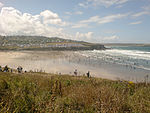Penmayne
Cornwall geography stubsHamlets in CornwallManors in Cornwall
Penmayne is a hamlet next to Splatt in the civil parish of St Minver Lowlands in north Cornwall, England, UK.In the Middle Ages Penmayne (a sub-manor of Helston-in-Trigg) was one of the Antiqua maneria (ancient manors), the original 17 manors belonging to the Earldom of Cornwall.
Excerpt from the Wikipedia article Penmayne (License: CC BY-SA 3.0, Authors).Penmayne
Cricketers Hollow,
Geographical coordinates (GPS) Address Nearby Places Show on map
Geographical coordinates (GPS)
| Latitude | Longitude |
|---|---|
| N 50.548 ° | E -4.901 ° |
Address
Cricketers Hollow
Cricketers Hollow
PL27 6LZ , St. Minver Lowlands
England, United Kingdom
Open on Google Maps











